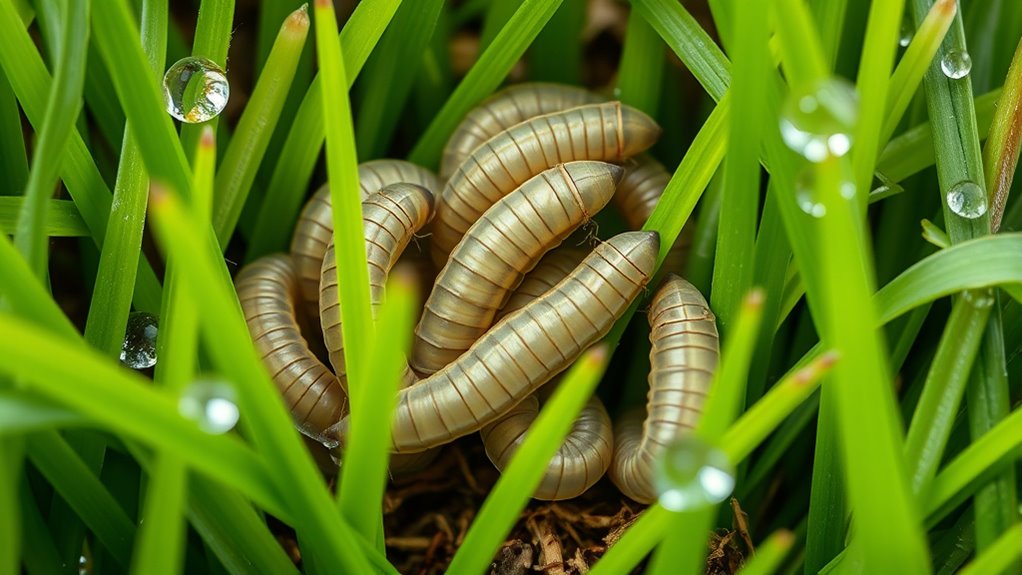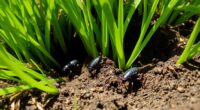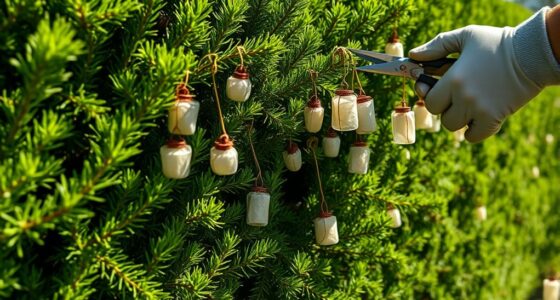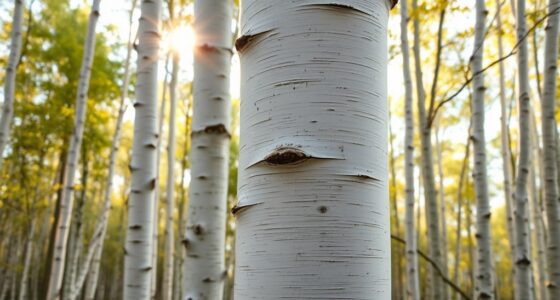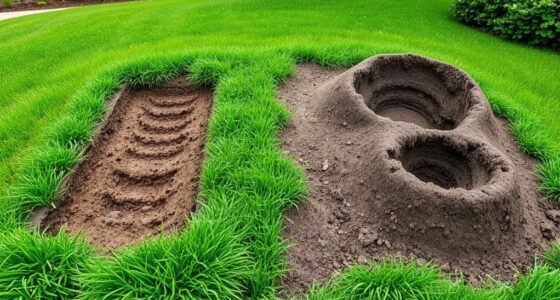If you notice patches of thinning or dead grass in your lawn, you might have crane fly larvae, also called leatherjackets, underground. These grubs feed on roots and organic matter, causing damage mostly in spring or fall. To manage them, consider biological controls like beneficial nematodes or use insecticides such as imidacloprid safely. Keeping your lawn healthy with proper watering, mowing, and aeration can also help prevent infestations. Learn more tips to protect your lawn effectively.
Key Takeaways
- Leatherjackets are gray or brown lawn grubs that damage turf by feeding on roots.
- Look for thinning patches, yellowing grass, or dead spots as signs of infestation.
- Use biological controls like beneficial nematodes or insecticides such as imidacloprid for management.
- Maintain a healthy lawn through proper mowing, watering, fertilizing, and aeration to resist pests.
- Early detection and professional advice improve control and minimize lawn damage.

Crane fly larvae, often called leatherjackets, can become a common problem for homeowners with lush lawns. These gray or brown grubs live underground, feeding on grassroots and organic matter, which can lead to noticeable patches of thinning turf or dead spots. Once they infest your lawn, they can cause significant damage if not addressed promptly. The key to managing these pests lies in effective pest control strategies combined with strong lawn health management. By understanding their behavior and lifecycle, you can implement targeted actions that minimize their impact and protect your grass.
Crane fly larvae, or leatherjackets, damage lawns by feeding underground, causing thinning turf and dead spots.
Start by inspecting your lawn regularly, especially in early spring or fall when leatherjackets are most active. Look for signs such as irregular patches of yellowing or thinning grass, which often indicate larval feeding. If you notice these symptoms, consider a soil test to confirm the presence of larvae. Once confirmed, you can employ specific pest control strategies, such as applying beneficial nematodes, which are microscopic worms that naturally prey on leatherjackets. These biological controls are environmentally friendly and effective when used correctly. Additionally, insecticidal treatments containing active ingredients like imidacloprid or chlorantraniliprole can be applied, but always follow the manufacturer’s instructions for safety and maximum efficacy.
Beyond direct pest control, lawn health management plays a essential role in preventing infestations. Maintain a healthy, vigorous lawn by mowing at the proper height, watering deeply but infrequently, and fertilizing appropriately. A dense, well-nourished turf is more resistant to pest damage and less attractive to larvae. Aeration can also help improve soil health and reduce compaction, making it harder for leatherjackets to establish. Removing thatch buildup is equally important, as it creates a favorable environment for larvae to hide and feed. Using appropriate lawn care tools like aerators and dethatchers can support these efforts and enhance overall turf resilience.
Timing your interventions is critical. Applying pest control methods early in the season or when you first notice signs of damage can prevent populations from exploding. Keep your lawn healthy year-round to make it less hospitable for these pests. If you’re unsure about identifying leatherjackets or choosing the right control methods, consulting with a lawn care professional can save you time and effort. They can provide tailored advice and treatments based on your specific conditions.
Frequently Asked Questions
Are Crane Fly Larvae Harmful to Pets or Children?
Crane fly larvae are generally harmless to pets and children, but it’s best to exercise caution. They aren’t toxic, so pet safety and child protection aren’t major concerns. However, children might be tempted to touch or play with them, risking minor skin irritation or allergic reactions. To guarantee safety, discourage contact and keep your pets and kids away from the larvae. Always consult a professional if you’re unsure about specific health risks.
How Can I Prevent Crane Fly Larvae From Infesting My Lawn?
To prevent crane fly larvae from infesting your lawn, start by aerating your lawn regularly to improve drainage and reduce organic matter that larvae feed on. Apply organic treatments like neem oil or beneficial nematodes, which target larvae without harming your lawn or pets. Keep your lawn healthy with proper watering and mowing practices, making it less attractive to crane flies and their larvae.
What Natural Predators Control Crane Fly Larvae Populations?
Imagine your lawn thriving thanks to natural pest control. Birds are excellent predators of crane fly larvae, often reducing their numbers markedly. Additionally, beneficial nematodes can be applied to your soil, actively seeking out and killing larvae underground. Incorporating bird-friendly features like birdhouses and planting native vegetation encourages their presence, while nematode treatments offer a chemical-free solution. Together, bird predation and nematodes form an effective, eco-friendly defense against crane fly larvae.
Do Crane Fly Larvae Cause Long-Term Damage to Soil Health?
Crane fly larvae rarely cause long-term damage to soil health. They typically don’t lead to significant soil degradation or nutrient imbalance. However, in severe infestations, they can harm turf roots, affecting plant growth temporarily. You can manage populations before they cause lasting issues by encouraging natural predators and maintaining healthy soil. Regular lawn checks help prevent minor problems from escalating into long-term damage.
Can Crane Fly Larvae Be Used as Compost or Fertilizer?
Crane fly larvae can’t be used directly as compost or fertilizer, but they can contribute to composting benefits when broken down naturally. Their presence indicates healthy soil activity, and as they decompose, they add nutrients that enhance soil fertility. Think of them as nature’s recyclers, transforming organic matter into fertilizer potential, enriching your soil. While not a fertilizer themselves, their role supports a thriving, nutrient-rich garden ecosystem.
Conclusion
Dealing with crane fly larvae can feel like trying to tame a wild beast, but with the right steps, you can restore your lawn’s health. Keep an eye out for signs of damage and act quickly before they spread like wildfire. Regular lawn maintenance, proper watering, and targeted treatments will help you regain control. Remember, your lawn’s resilience is like a phoenix—ready to rise from the ashes with a little care and attention.
